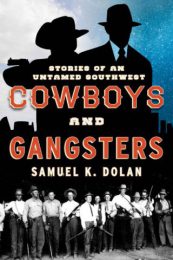While most American historical books concentrate on just one period of time, one group of individuals or precisely one cultural event in American history, in Cowboys and Gangsters, we encounter quite a gripping set of bygone and cultural crossroads.
Author Samuel K. Dolan, a movie director,  documentary writer and producer, tells of both the last days of the western lawmen of the 1920s and early 1930s who still worked and lived in the tradition of the western crime fighters of the 20th century. He also tells about the beginning of the American Prohibition era, when those same lawmen were confronted with motorized bank robbers, organized crime, moon shiners, and shootouts in high speed cars, instead of gun battles on horseback.
documentary writer and producer, tells of both the last days of the western lawmen of the 1920s and early 1930s who still worked and lived in the tradition of the western crime fighters of the 20th century. He also tells about the beginning of the American Prohibition era, when those same lawmen were confronted with motorized bank robbers, organized crime, moon shiners, and shootouts in high speed cars, instead of gun battles on horseback.
His well researched study gives a detailed account of the two eras that converged for almost two decades.
“…[T]he brand of Western lawman … in the Southwest during the Prohibition Era […] patrolling the borderlands and mining towns of Arizona, New Mexico, and Texas had one foot in each century, adapting to the technology of automobiles and telephones while still climbing into the saddle when pursuing fugitives into those areas where a car was next to useless.”
Dolan collected dozens of stories about many legendary, but now unremembered Sheriffs, Deputies and lawmen who told their stories of authentic cases; however, those crimes happened not in the modern big cities or on the East coast, where one expects mobsters and organized crime connected with the Prohibition in the first place, but in the dry and dusty towns of the West and the border regions of Mexico.
The reasons for the documented violence in the Southwest of that time were mostly alcohol smuggling (Arizona had already introduced Prohibition in 1915, New Mexico in 1918), drugs, labor disputes, general tension between Anglos and Hispanics and effects of the Mexican Revolution that sometimes led insurgents straight across the border into Arizona, New Mexico, California and Texas.
Dolan cites countless newspaper articles, case files, personal memories and interviews with the Deputies and the Sheriffs; this, as well as a very solid background of the histories of the border states makes his book a good piece of research on the border regions of the Southwest.
Even if this sounds a bit boring at first: any of the old Sheriffs’ stories held more action, excitement, and drama than any modern Hollywood movie! It is the authenticity of the incidents: they are all “true crime” stories.
Recommended reading for anybody interested in the history of the border regions.
Review by Dr. A. Ebert © 2017
Samuel K. Dolan. Cowboys and Gangsters: Stories of an Untamed Southwest. Rowman & Littlefield, 2016, 352 p.
